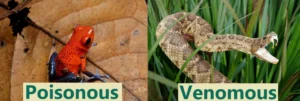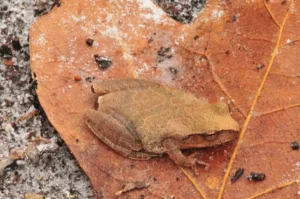Spring peepers are small, slender tree frogs found throughout much of the eastern part of North America. These frogs can be easily identified by their tan or light brown coloration with a dark X-shaped marking on their back. But are spring peepers poisonous?
Spring peeper frogs are not poisonous. They do not produce any skin toxins and are generally harmless to humans, dogs, cats, or any other pets. The only real threat they pose is that, like many amphibians, they can be carriers of salmonella bacteria, which can be harmful to humans, or pets.
Spring peepers are otherwise harmless creatures. Just practice a sufficient level of hygiene (such as washing your hands after handling any spring peepers), and you will be fine.
Spring Peepers Do Not Produce Skin Toxins
However, this does not mean spring peepers are defenseless when it comes to fending off predators. They have other ways to protect themselves.
Spring Peepers Do Not Have Venom
If you are like most people, you have probably (at least once) used the words “venomous” and “poisonous” interchangeably. But you should know that there is a significant difference between these two terms.
Sure, they both refer to toxins that could be harmful to us, but the difference lies in how these toxins are delivered.
Generally;
- Venom is actively injected, usually through stings, fangs, or barbs (think rattlesnakes, scorpions).
- Poison on the other hand is delivered much more passively and has to be absorbed/ingested into your body. It can be ingested when it comes into contact with your eyes, lips, mucus lining of the nose, or open cuts on your skin (think poison dart frogs).
In other words, if an animal has to bite or sting you to inject its toxins it is venomous. If an animal secretes its toxins on its skin, then you can ingest those toxins when you eat, lick or touch the animal, it is poisonous.

Spring peepers do not secrete toxins on their skin and neither do they have the ability to inject any toxins. For this reason, they are not venomous or poisonous.
How Do Spring Peepers Defend Themselves?
Since spring peepers do not have any toxins, they may seem defenseless when it comes to fending off hungry predators. However, they have a few tricks to keep predators away.
As the first line of defense, spring peepers have an inconspicuous coloration that helps them blend into the leaves and other debris in their environments, escaping the notice of most predators.

However, sometimes camouflage alone is not enough, so spring peepers are also very strong jumpers. If they see a predator getting too close, they can use their powerful hind legs to leap a distance of up to 17.5 inches and escape.
One study observed several species of frogs and found that spring peepers had the least degradation of performance in repeated jumps. This means they can repeatedly leap large distances to slip away from predators.
Are Spring Peepers Dangerous to Humans?
Since spring peepers do not secrete any toxins, they are generally harmless to humans. That being said, it is important to note that almost all frogs can carry salmonella bacteria, which can be harmful to humans.
Spring peepers can carry salmonella bacteria in their digestive tract and excrete it in their waste. The bacteria do not cause any illness in the frog – so a spring peeper carrying salmonella bacteria can look clean and healthy, but the bacteria can be transmitted to humans.

Humans can be exposed to salmonella by direct or indirect contact with a frog, its waste, or anything the frog came in contact with. (For example, you touch a spring peeper or its droppings, then stick your fingers into your mouth without first washing your hands).
Exposure to salmonella can cause an infection called Salmonellosis which is characterized by stomach cramps, diarrhea, fever, nausea, and sometimes vomiting.
Most infections only cause mild illness, but sometimes, the bacteria can spread to the bloodstream leading to serious illness.
Fortunately, merely touching a spring peeper frog will not give you a salmonella infection. The bacteria can only cause illness when they are ingested. Therefore, thoroughly washing your hands immediately after touching any spring peepers should keep you out of harm’s way.
Are Spring Peepers Poisonous to Dogs, or Cats?
Spring peepers do not have any toxins so they are typically harmless to dogs, cats, or other pets, even if eaten.
However, as mentioned earlier, all frogs can carry salmonella bacteria so a dog or cat that mouths, bites or eats a spring peeper may consume the bacteria and develop an infection.
Also, frogs can carry tapeworms and other parasites. This means if a dog eats a spring peeper, it may also consume parasites and develop a parasitic infection.
For this reason, it’s a good idea to keep your pets away from any frogs, even if they are not toxic.
Safety Precautions to Take When Handling Spring Peepers
Generally, it is not a good idea to handle amphibians. This is because they have very sensitive permeable skin that absorbs water and other substances it comes in contact with.
If you touch a frog, – salts, oils, lotions, perfumes, repellents, and other substances on your hands can be absorbed right through its skin, and hurt, or even potentially kill the frog.
For this reason, it’s advisable to observe frogs from a distance without physically touching them.
If you ever need to handle a spring peeper frog (such as moving it out of harm’s way), take the following precautions to protect both you and the animal.
Before Handling
- Wash your hands EXTREMELY so they are very clean. Not just clean from dirt, but from perfumes, lotions, or any other substances that could harm the frog, and be sure that no soap residue remains on your hands.
- After washing your hands, dry them (preferably with paper towels), then re-moisten with dechlorinated water.
Even better, you could wear protective gloves (powder-free vinyl gloves or nitrile gloves).
Wearing gloves will not only prevent you from coming in contact with bacteria that may be on the frogs’ skin but will also protect the frog from harmful substances you may have on your hands.
The gloves also have to be moistened with dechlorinated water.
When Handling
- Keep the frog away from your eyes, nose, and mouth and, be very careful not to rub your eyes, or touch your nose, or mouth.
- As you handle the frog, do it very gently and with care so you do not injure or stress the toad in any way. Avoid squeezing the frog too hard, or applying too much pressure on it.
Frogs should only be handled for a short time. Handling a frog too long can cause stress to the animal and dry out its skin.
What to Do After Handling
- Very thoroughly wash your hands with anti-bacterial soap under running water.
Even if you were wearing gloves, it is still a good idea to go the extra mile by washing your hands. As earlier mentioned, spring peepers may carry bacteria that can be harmful, so it’s best to protect yourself.
Before washing your hands, do not touch anything (you could spread bacteria) – and remember not to rub your eyes, touch your face, or put anything into your mouth.
Frequently Asked Questions (FAQS)
Are spring peeper frogs poisonous to touch? Spring peepers are not poisonous to touch. They do not produce any toxic skin secretions and are generally harmless. However, touching a spring peeper could expose you to salmonella bacteria, which can be harmful when it gets into your body.
Are spring peeper frogs poisonous to humans? No, spring pepper frogs are not poisonous to humans. They do not produce any poisonous skin secretions and are generally harmless to humans. The only real threat they pose is that they can be carriers of salmonella bacteria which can be passed on to humans if sufficient hygiene is not practiced.
Are spring peeper frogs poisonous to dogs? No, spring peeper frogs are not poisonous to dogs. They do not produce any toxic secretions and are typically harmless to dogs, even if eaten. The only real danger these frogs pose is that they can be carriers of salmonella bacteria or parasites which can be passed on to dogs.
Are spring peeper frogs poisonous to cats? No, spring peeper frogs are not poisonous to cats. However, they can be carriers of salmonella bacteria or parasites which can be passed on to cats, when the frogs are eaten.
Do spring peeper frogs bite? Spring peeper frogs can bite, but this is very rare. They will only nip at a human if they are being handled in a way that causes them a lot of stress. Their bite is nothing to be worried about because it is unlikely to hurt and is not venomous or dangerous in any way.
Conclusion
Spring peepers are interesting frogs that are unlikely to ever cause you any problems.
The only real danger they pose is that they can be carriers of salmonella bacteria, which can be harmful to humans. However, the risk of getting a salmonella infection can be significantly reduced by taking a few simple safety precautions
When left alone (or when handled with care), spring peepers are completely harmless creatures.
Photo credit: Geoff Gallice from Gainesville, FL, USA, CC BY 2.0, via Wikimedia Commons, and paul_dennehy/inaturalist.


